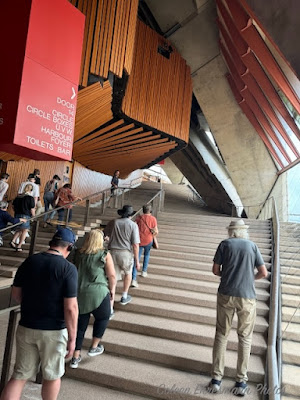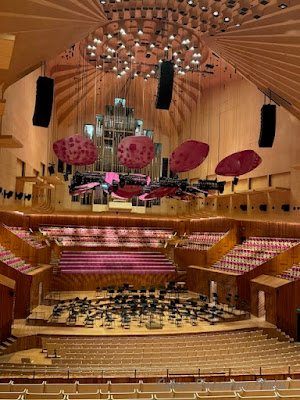Our cruise ship docked in Sydney before 6:00AM on March 28th and the seven of us were off the ship before 7:30 headed to our hotels to drop off luggage. Two of the couples were staying close to the Sydney Opera House but our hotel was in the city center, too far to walk, but a perfect location for the train system. I had booked a behind the scenes tour for the seven of us for 12:45 PM.
Booking a tour is the only way to see the inside of the iconic Sydney Opera House unless attending an event.
The Opera House hosts 1500 performances annually attended by 1.2 million people.
Although planning for a larger Sydney building to host opera and other music venues began in 1940, it wasn't until 1955 when a contest was held for a design for a the new building that serious steps were taken. Danish architect Jørn Utzon's design was selected. The Opera House was built in four stages: stage I (1957–1959) was planning out the building; stage II (1959–1963) consisted of building the upper podium; stage III (1963–1967) the construction of the outer shells, based upon the image of whales breaching the water; stage IV (1967–1973) interior design and construction.
We are standing at the lower level where there are restaurants, a gift shop, and restrooms. This is where our tour began. The people standing at the railing are on the podium area of the Opera House where the official front door(s) are located. Our Viator tour cost $27 pp and included a meal and adult beverage AND a full hour with a knowledgable tour guide. What a bargain!
Utzon resigned February 1966 due to political pressure and conflicts between the government, engineers and planners. He returned to Denmark and never came back to Sydney to see the project he had started, despite being asked to return numerous times. Australian architect, Peter Hall was selected to complete Utzon's design for the structure.
The Sydney Opera House was officially completed in 1973 at a cost of $102 million, ten years later than projected and at a cost of $1357% over budget.
We were told at the start of the tour there would be 200-300 steps to climb during the tour. Surprisingly none of us felt like we had climbed that many steps. The steps in the opera house are at a 6 inch rise and not the typical 8 inch rise. Another surprising feature was the heated hand rails. Our guide told us the hand rails are lighted beneath, gently warming the metal.
Hubby found a nice spot to watch the video our guide shared with our group of about 30.
The Opera House’s interior spaces include a recording studio, restaurants, and five theaters; its largest theater is the Concert Hall.
Utzon wanted the shells to contrast with the deep blue of Sydney Harbour and the clear blue of the Australian sky. The tiles needed to be gloss but not be so mirror-like to cause glare. A company from Sweden worked for three years to get the effect Utzon wanted. Each clay tile is 120mm square or 4.72 square inches. In total, there are 1,056,006 tiles on the roof. The roof is checked very thoroughly every five years and only 4 or 5 tiles need replacement out of the 1 million. Amazing! The tiles are never scrubbed. They are self-cleaning because of the slope of the shells and the glazing on the clay and crushed granite tiles.The impressive and subtle chevron pattern has glossy white-matte (light blue looking) & cream-colored tiles manufactured by Höganäs AB of Sweden. These ceramic tiles are fungus-proof and the white and cream finish catches the light & mirrors the sky from dawn to dusk, every single day of the year.
We were allowed to take photos in the Concert Hall. It seats 2,679, is the home of the Sydney Symphony Orchestra and used by a large number of other concert presenters. It contains the Sydney Opera House Grand Organ, the largest mechanical tracker action organ in the world, with over 10,000 pipes. (Our guide told us the organ is played maybe twice a year.)
The concert hall went through a major renovation in 2020 increasing the acoustics for all types of venues from rock bands to symphonies. The flowered umbrellas (maybe 16 of them?) can be individually moved and tilted to give the musicians and audience the perfect sound.
The wood panels surrounding the orchestra floor is rippled, helping to promote the perfect middle C pitch. The wooden shelves just below the umbrellas are also maneuvered to create a perfect acoustical experience. The white birch seats are ergonomically designed for audience comfort.
another photo of the 10,000 pipe organ and the umbrellas
the organ stands 50' tall and weighs 37.5 tons
another photo of the birch wood seats and the wavy wood panels
We did not get to take pictures of the opera or ballet venue, the Joan Sutherland Theater because staff was getting ready for a future performance. It too, was a state of the art hall with more features than I can remember. Scenery is built on backdrops that rise from the basement. I think there were 14 backdrops that can be raised and lowered during any performance. It is the second largest venue and seats 1507. It features an extensive fly system and flexible staging and is suitable for all genres.
Across from the Opera House is the Royal Botanical Gardens. The steps leading to the podium area of the Opera House are designed for tiered seating for outdoor venues.
The following day we had an opportunity to ride the ferry in Sydney Harbor giving us views of the Opera House only seen from the water.
Utzon wanted glass walls so views of the harbor could be seen from any direction in the building.
Another view from the harbor
The famous Sydney Bridge at Sydney Harbor. Nicknamed "The Coathanger" because of its arch-based design, the bridge carries rail, vehicular, bicycle and pedestrian traffic. The bridge officially opened in 1932.
We saw people climbing the bridge. It takes approximately 2 hours to reach the Summit. This includes time to suit-up and complete the pre-climb safety preparation. The descent takes about an hour. The adventure costs about $384 to experience walking along catwalks, climbing ladders and stairs (1,300+), and enjoying one of the world's most breathtaking views.
my brother and his wife joined us on the cruise
my sister-in-law took a photo of the opera house at night




















No comments:
Post a Comment
Thanks for your comments!